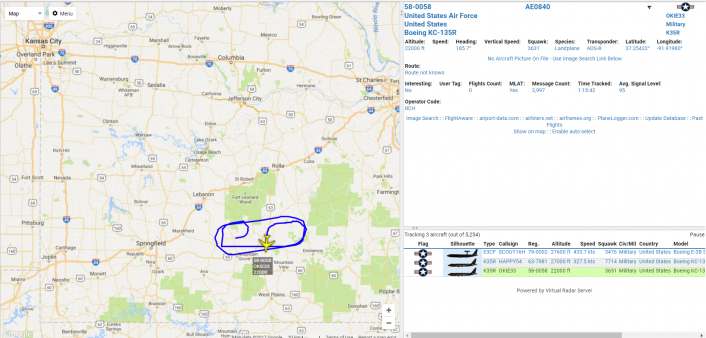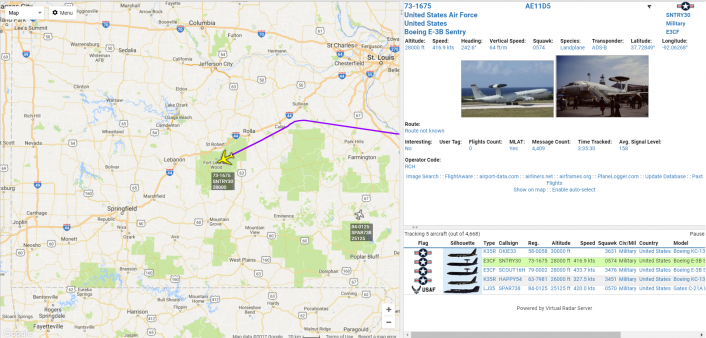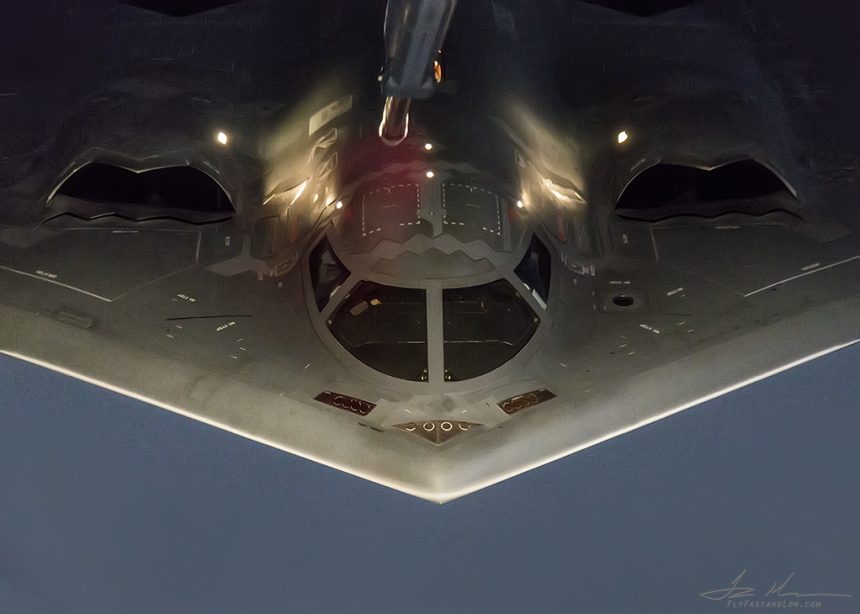Some unusual activity took place in the skies over Missouri a couple of weeks ago. Including B-2s referring to air strikes on DPKR target on the radio. Just routine stuff or a message to Pyongyang?
What appears to be a medium size exercise, involving several different assets, took place over CONUS (Continental U.S.) in the night on Oct. 19 and Oct. 18, 2017.
Tons of military traffic, including B-2s and B-52s bombers, E-3 Sentry AEW (Airborne Early Warning) aircraft supported by KC-10 and KC-135 tankers were involved in a series of simulated air strikes on little airports all over Missouri. Radio comms over unencrypted UHF frequencies as well as the use of Mode-S and ADS-B transponders allowed milair airband listeners in the area to monitor the operations and to catch some interesting details. Besides the rather unusual amount of traffic (at least according to people who have been monitoring military air traffic through radio scanner for the last 15 years), what is really interesting is the fact that, during one night, one of the aircraft radioed a message about a “possible DPRK leadership relocation site” whose coordinates pointed to a hangar located at the Jefferson City airport.
This is what one of our readers wrote to us:
On the evening of Oct. 17, my wife and I where sitting outside by a fire enjoying the evening.
Around 8pm we saw three B-2s and what appeared to be a KC-135 fly over on a heading of roughly 080 and an altitude of 25,000 or below. It was after dark but at that altitude B-2s are easily identifiable if they have navigation lights and strobes on from directly underneath. We get quite a few military aircraft in eastern Kansas and this was nothing unusual.
I have been monitoring military air-air communications as a side hobby for a number of years so B-2s as well so the overflight prompted me to run and grab a handheld scanner. Shortly after turning on the scanner I heard the B-2s working Kansas City center using “BATT” [a previous version of this article referred to the c/s as “Bat”, however, Spirit pilots pointed out the right c/s is “Batt”] callsigns (most of the time they tend to use REAPER or DEATH).
After about 30min had passed, I picked up the B-2s and other aircraft on another frequency where they where using military brevity. It was clear they where simulating some kind of battle. They where talking to another callsign MOJO getting tasking to drop GBUs on different targets. They read some target Lat/Lon over the radio: quickly plugging one into Google Maps I found they where dropping bombs on a hanger at Jefferson City, MO, airport going as far as discussing the fusing time for best effect on target.
The next evening I was ready if the exercise continued with more receivers in place and proper recording software. About the same time (roughly 8pm) they started up dropping bombs on targets with tasking from MOJO and WOLVERINE. One of the targets, consisting of several Lat/Lon sets, was the runway and hangers at Osage Beach, MO airport. At one point they called friendlies in contact and proceeded with a danger close 150m airdrop at the same hangar at Jefferson City airport as the night before.
This is the first time I have heard a exercise of this magnitude over this area.
The first night they tried to use HAVE QUICK frequency hopping and I heard several timing pulses but they couldn’t seem to get all of the members of the net setup properly (that could have been planed to practice contingency plans). They also didn’t employ any encryption that I could hear so the whole exercise was broadcast for the world to hear in plain old analog UHF AM. The most interesting part was when they radioed “a command post possible DPRK leadership relocation site” but when this was said I had not started recording it yet.
My opinion is that the Missouri Ozarks look a lot like North Korea, but we have no way of telling if something is planend or they are just preparing in case things go south.
The amount of money spent and the number of national assets involved sets this far above anything I have heard around here.”
Here below you can hear what this reader has recorded during the above drills. It’s just a 5-min audio file cut from a longer +30min version. However it gives pretty much an idea of what was happening on Oct. 18.
Was the exercise aimed at simulating a raid on a North Korean “VIP”?
Most probably yes. This is something that is being planned for months. Night missions of three-ship B-2 flights (using the very same callsign “Batt”) are standard practice as our recent story of three Spirit stealth bombers refueling over southwest Missouri few days before the above exercise was monitored proves.
What is weird is the fact that radio comms included a clear reference to a DPKR target. Indeed, it’s no secret that thousand radiohams, aviation geeks, aircraft spotters etc. use radio transmission to track military air traffic. For this reason, real ops are always conducted with a strict radio discipline, so that no detail is leaked to the “enemy” (or anyone who should not have the right to listen) and encrypted radio frequencies or frequency hopping techniques are used. However, the whole exercise was carried out on very well known unencrypted frequencies. This could have happened because of a mistake (usually names of enemy nations are never specified during radio comms) or on purpose, to let the word spread that the B-2 are preparing to attack North Korean targets. A sort of subliminal message such as the one sent with a video that showed, for the very first time, a Spirit bomber drop a 30,000-pound MOP (Massive Ordnance Penetrator) “Bunker Buster” bomb or one of the various show of force missions flown from the U.S. (or Guam) to the Korean peninsula.
A @Whiteman_AFB B-2 flew a long-range mission to @PacificCommand AOR this weekend; these missions demonstrate our commitment to allies. pic.twitter.com/Pzx2hCGHyS
— US Strategic Command (@US_Stratcom) October 29, 2017
Dealing with Mode-S transponders, these made some of the aircraft involved in the ops, visibile on flight tracking websites. However, this is far from being unusual: despite the risk of breaking OPSEC with an inaccurate use of ADS-B transponders many aircraft, including RC-135s, Global Hawks and other strategic ISR platforms operate over highly sensitive regions, such as Ukraine or the Korean Peninsula, with the ADS-B and Mode-S turned on, so that even commercial off the shelf receivers (or public tracking websites) can monitor them.


Top image: Todd Miller









